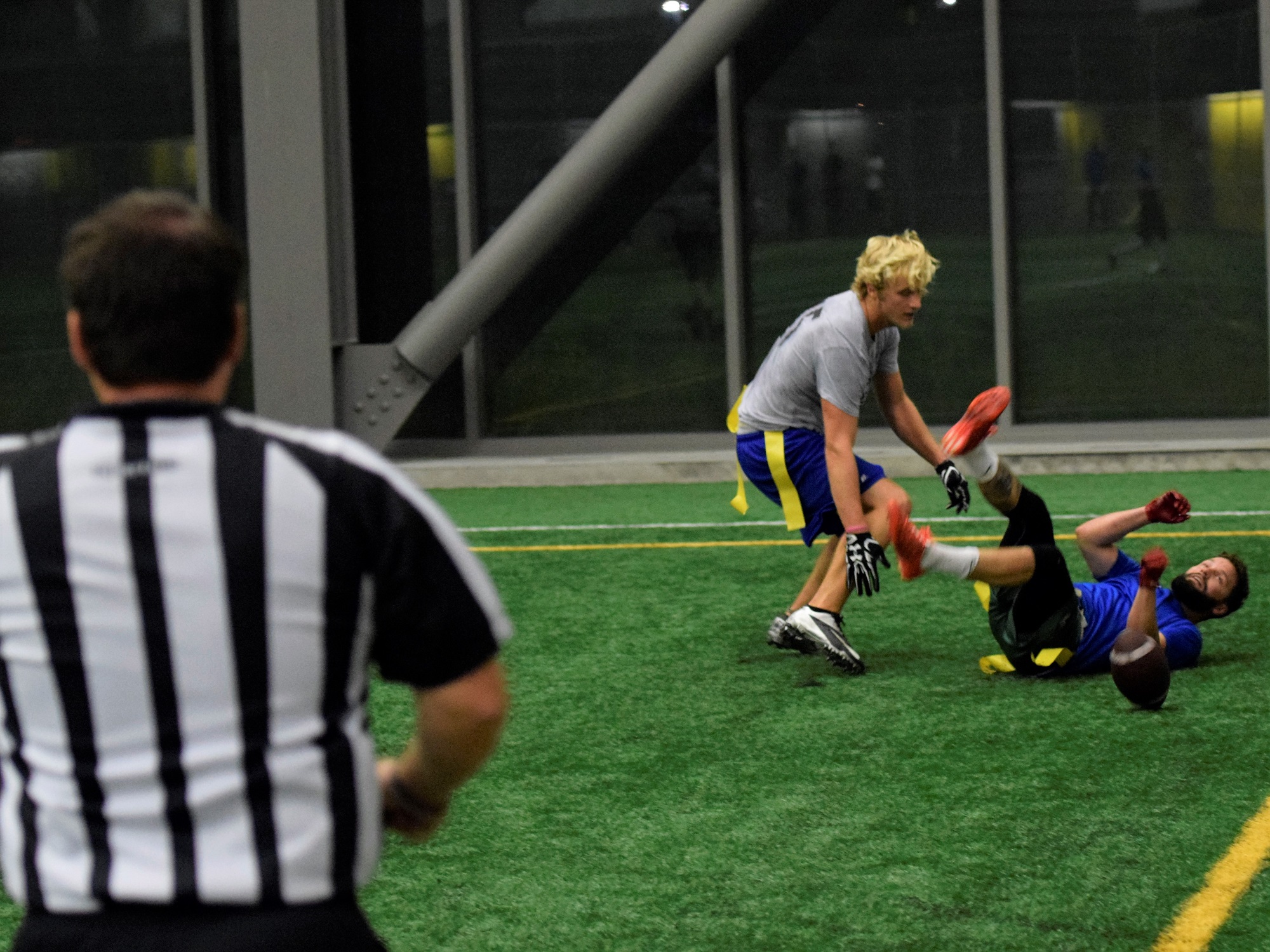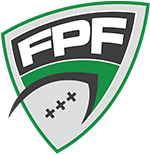Behind Enemy Lines: Contacting the Passer, Intentional Grounding

In light of the recent celebration of International Women’s Day, I would like to open the second edition of the Behind Enemy Lines segment with a shout out to the 4 women who are part of the FPF officiating Roster: Tara, Georgina, Cat and Judith. Each of these women brings a new and positive perspective to officiating football and we are lucky to have them. Happy International Women’s Day to you all!
In this segment, we will delve into two topics which garner a lot of interest weekly: contacting / roughing the passer and a personal favorite of ours, intentional grounding.
First, let us begin with the protection afforded to the quarterback. Very simply put, a quarterback should have an unrestricted opportunity to set their feet and throw a pass without contact from the rusher (or any other defensive player). As I am sure you can all appreciate, throwing a pass places you in a vulnerable position with respect to an oncoming rusher, and as a result there is zero tolerance for any contact to the passer’s arm, hand or body. Note that the penalty is contacting the “passer” and not contacting the “quarterback”; essentially the same protection is granted to any offensive player throwing a pass.
Let us elaborate on the contact to the passer’s arm. While the rusher can in fact attempt to tip or deflect a pass by putting their hands up, the rusher does so at their own risk. If the quarterbacks arm in any way contacts to outstretched arms of the rusher, a penalty will be called against the rusher. This is true even if it is the passers normal follow-through that makes contact with the rusher. We often get pleas of innocence from rushers, saying “but ref…the quarterback hit me!!”… to which we will certainly agree, and then apply the penalty for contacting the passer.
To briefly summarize, the rusher is encouraged to play the flags of the quarterback. Any contact to the passers arm or body, while in a vulnerable passing motion will be penalized. It does not matter how slight or incidental the contact is, or if it is the quarterback that hits the rusher with a normal follow through.
Now let us consider deflecting the ball itself. This weekend in a Division 4A game, the rusher came through to the quarterback and hit the ball which was in the quarterback’s cocked arm as he prepared to throw. There is no question that the rusher struck all ball in a rejection that would have had Mutombo wagging his finger…but the ball was still in the quarterback’s hand. The rule states clearly that the ball, in the quarterback’s hand, is considered part of the passer’s arm, and as a result this great basketball block is a foul in flag football. So please, rushers, as you get close to the quarterback, make sure you shift your attention from ball to flags to protect the passers in the league, and your team from a 10 yard penalty. Remember, if the contact is deemed to be significant in nature (we cannot measure intent because we are not mind-readers, so we measure severity), the rusher can be penalized for roughing, get sent off for 5 plays, and have the UR penalty recorded on the scoresheet.
Another passing penalty that we hear a lot of grumblings about, and understandably so, is intentional grounding. Let us ponder 2 different scenarios.
It is 3rd down and 1 for the offense. The quarterback gets the snap, makes a quick read and wants to throw a quick out pattern to the sideline. Seeing that the defender jumped that route, he intentionally throws the ball well over the receiver’s head into the netting. The result: The defense celebrates a great defensive play and pats the defender on the back!
The next scenario is 1st down and 10 at their own 5 yard line, with 4 plays left, winning by 4 points. The quarterback, not wanting to take any chances, gets the snap, and throws the ball over the receivers head into the netting. The result: The defense is furious that we are not calling intentional grounding!
We completely get it, the quarterback is not putting the ball in play and you are so desperate for a stroke of luck to get the ball back to try and win the game, but neither of these two scenarios is a penalty in FPF.
Why wouldn’t it be? Well, simply put, the rule states that the quarterback needs to throw the ball to area where there isn’t a receiver to avoid a loss. This means that the quarterback needs to be under pressure from the rusher, and trying to avoid the sack just dumps the ball to an open area. It is not a penalty to deliberately throw a pass over a receivers head into the netting, towards a receiver’s feet, or even over throw a receiver by 20 yards because they do not want to risk a turnover late in the game. In other words, this is allowed, as frustrating as it may be to be on the receiving end of it.
I was going to leave the mercy rule conversation until the next article, but this is a good segway. As you are all aware, and probably have been inconvenienced by this rule once or twice, there are times in which the game can be ended by the offense. If the winning team has the ball, are not inside their own 10-yard line, and can run out the number of remaining plays (i.e. 1st Down and 4 plays left), they can call the game. A few facts to consider – 1) the Quarterback can just throw the ball away 4 times and it would not be considered intentional grounding 2) We played 44 minutes of football plus at least 6 plays, the losing team is NOT in possession of the ball, the odds are not in your favor. I get it, there is always a chance that a snap goes over the quarterback’s head…this is why the offense needs to be at the 10 yard line as a minimum to end the game. But there is also the risk of injury, or worse, a team getting frustrated by the offense deliberately throwing the ball away, or taking a knee etc. and doing something out of anger. This is a recreational league where sportsmanship should be at the fore-front. When the game has come down to 4 plays or less, you are losing and don’t have the ball, the game is over – shake hands and move on. Those 4 plays, which likely wouldn’t have had any substance to them anyway, are not going to be the way that you extract value from the league.
The rules committee often ponders this rule. So let’s address some of the finer points. The only thing we don’t want quarterbacks doing is randomly throwing the ball away as the rusher is just about to get their flag, this is definitely gaining an advantage. But in most other scenarios, what do they gain? They can waste a play by throwing the ball poorly. Sometimes there are misunderstandings and a receiver zigs instead of zags, there is no penalty there. And remember, every time a quarterback does this, the defense is one play closer to getting the ball back. And for the second time this article, we cannot measure intent, we aren’t in the quarterbacks’ heads (thankfully).
To sum up, the quarterbacks arm and body are completely off limits when it comes to passing situations, make sure to play the flags and keep the quarterbacks safe. In order to get an intentional grounding call in FPF, the quarterback must be dumping the ball to avoid a loss, meaning they are trying to avoid a sack so they just throw the ball away. This also means that throwing the ball over a receiver’s head on purpose is well within the rules provided that they are not under immediate duress at the time of the pass. We know this can be frustrating, which is in large part why we allow the offense to end the game if they are winning and can run out the remaining plays. We don’t want a quarterback launching the ball down the field 3 times and then punting to end the game.
We hope that this was a helpful look into some of the controversial aspects of the game. If there are any items which you would like to have discussed in this article, please send us an e-mail to [email protected]. For the player who said Jason refs worse than their grandma….funny, but those won’t make an appearance in this article…or did it?
Thank you.


